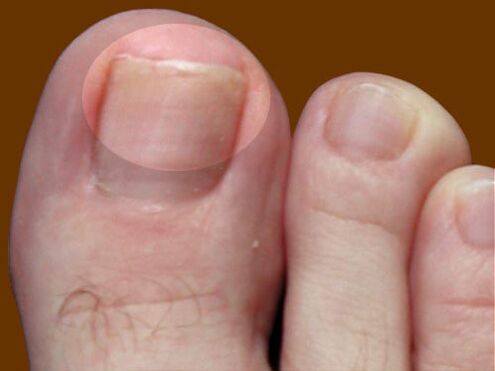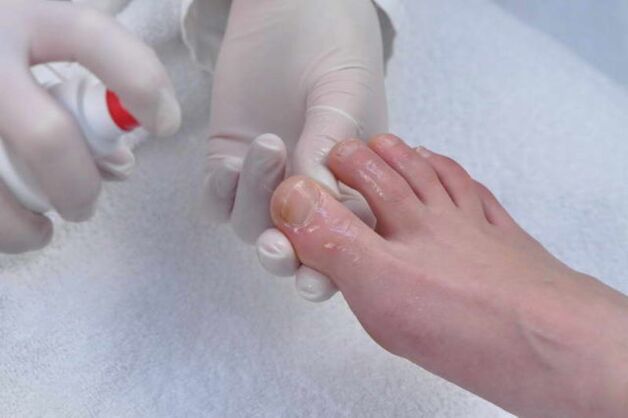The initial stage of nail fungus (onychomycosis) occurs without any noticeable symptoms.Minor changes in the appearance of the nail plate are observed, minimal discomfort is possible, so diagnosing the disease at this stage is quite difficult.

Symptoms: What does nail fungus look like in the early stages?
The first signs of nail mycosis appear almost immediately after infection.If your nails become dull and start to itch slightly after visiting public places such as a swimming pool, sauna, shower at the gym or beach, these may be the first signs of onychomycosis.
Healthy nails are practically not susceptible to fungal infections.It begins to develop rapidly when it comes into contact with just damaged nail plates.
In my arms
Fingernail fungus is more commonly diagnosed in women, but men are also susceptible to this disease.
The first symptoms of damage to the nail plate:
- the surface of the nail becomes dull;
- Spots appear, often white;
- the nail begins to change color, first it turns yellow, then it turns gray or brown;
- the nail begins to crumble at the edges, becomes brittle and flakes off;
- The skin around the plate may peel and swell, but this is rare in the early stages of the disease.
On my feet
You can recognize toenail fungus by the typical symptoms:
- the top or side of the nail begins to turn yellow;
- the nail plate gradually becomes thicker;
- the nail plate becomes dull, as a result the base is not visible;
- the nail begins to separate from the nail bed;
- there is a slight itching on the fingers;
- An unpleasant foot odor develops.
If treatment is not started on time, stage 1 of onychomycosis progresses rapidly.This causes the nail to deform and may come off completely.Toxic toxins released during the life of pathogenic fungi enter the bloodstream and spread throughout the body.This leads to a deterioration in metabolic processes and dysfunction of internal organs.
Important!Start treating nail mycoses at the first symptoms of the disease.
Treatment of the initial stage of the fungus
To treat onychomycosis in the early stages, in most cases medications that act locally directly on the affected nail are sufficient.In more advanced stages, tablets and injections are prescribed.

To treat nails at home, folk remedies are used.It is better to combine them with pharmacological drugs for external action.
Folk remedies
There are many folk remedies that can help cure nail fungus in the initial stages.Let's look at effective yet simple recipes.
- Iodine – Apply 1 drop of iodine 5% to affected nails daily until symptoms disappear.The procedure is carried out in the morning and also in the evening.Further material for iodine treatment.
- Mix 1 teaspoon of iodine, vinegar, glycerin and dilute with 6 teaspoons of water.Rub your nails with the resulting mixture for 10 days in a row.The composition must be left on the nail plate overnight.
- Vinegar – Prepare a bath by diluting 1 part 9% vinegar with 8 parts warm water.Let your feet or hands float in it for 20 minutes.Carry out 7 procedures every other day.Further material for vinegar treatment.
- Egg ointment – put a raw chicken egg in the shell into a glass and fill to the brim with 9% vinegar.When the shell dissolves, remove the remaining film and mix the egg with vinegar.Apply the resulting mixture to the affected areas twice a day for 2-3 weeks.
- Hydrogen peroxide – Dilute 2 tablespoons of hydrogen peroxide 3% in 2 liters of water.Steam your arms or legs, depending on where the fungus is located, for 20 minutes.Repeat the process for 7-10 days in a row.
- Peroxide compress – soak a cotton swab in peroxide and apply to nails that show signs of fungus.Beforehand, your hands or feet must be steamed in a soda bath.To prepare it, 1 teaspoon of soda is diluted in 1 liter of water.The top of the compress is wrapped in cellophane or cling film and left for 60 minutes.This is necessary so that the peroxide does not evaporate.Repeat the process twice daily for 10-14 days.
- Propolis tincture – Dip a cotton swab in 20% alcohol tincture of propolis and apply to affected areas.Keep the lotion until the composition dries.Repeat daily until recovery.1-2 procedures per day are enough.
- Washing powder is a suitable method for treating toenails.You need to dissolve 100 g of washing powder, which contains a lot of alkali, in 2 liters of water.Leave your feet in this bath for 15 minutes.Repeat 10-14 procedures until symptoms disappear.
- Garlic – Cut a peeled clove of garlic, dip it in salt, and then rub it on the nail plate.Repeat twice daily until symptoms disappear.
- Ammonia – dilute 1 tablespoon of ammonia in 1 glass of water.Cotton fabric is impregnated with the resulting solution.You need to wrap your legs or arms with it and leave this compress overnight.Repeat the process daily for 7 days.
- Onion – Chop the onion to a paste-like consistency and apply to the affected nails for 30 minutes.Repeat twice daily until recovery.
- Mix chamomile, sage, mint, you can take dry or fresh herbs.Place the resulting mixture in a sock or glove overnight.Herbs need to be changed every evening.Repeat the process in combination with other recipes until the fungal symptoms disappear.
- Boric Acid – Cotton swabs soaked in boric acid are applied to pre-steamed nails.You need to keep the lotion for 30 minutes.The process is repeated every day for 10 consecutive days.
- Celandine and tea tree oil - mix these products in equal proportions, soak a gauze bandage with the resulting mixture and apply to nails for 45 minutes for 20 days.The recipe is contraindicated for pregnant women.
- Baking soda – dilute baking soda with a little water to a paste-like consistency.Apply it to your nails for 20 minutes and then rinse with warm water twice a day for 10-12 days.
- Apple cider vinegar – dilute with olive oil.The required ratio is 2 parts vinegar to 1 part oil.Apply the mixture to the affected nail plates until the nail grows completely.
- Tea tree oil – Apply a few drops of oil to your nails until the fungal affected areas of the nail plate fully grow.
- Willow – Chop 500g of young willow sprouts, add 2 liters of water and bring to the boil.Make hand or foot baths from the prepared decoction three times a week for 20 minutes until recovery.
- Nettle – Brew 3 tablespoons of nettle leaves in 400 ml of water.Soak cotton swabs with this decoction and apply to the nail plates twice a day until recovery.
- Grind the rowan leaves, apply a thick layer to the nails, then wrap them in cling film for 30 minutes.Repeat the process daily for 12-14 days.

Before using folk remedies, it is necessary to check whether there is an individual intolerance to the components of the recipes.

Medication
After it has been possible to identify the type of fungus that has affected the nail, the doctor selects drugs that will contribute to the destruction of the nail.It is most convenient to treat the initial stage of onychomycosis with local remedies: varnishes, ointments and creams.Let's look at the most effective drugs.
Varnishes against mycosis
They are effective precisely in stage 1 of mycosis, when no more than 50% of the surface of the nail plate is affected.This product is convenient to apply and adheres well to the nail, allowing the active ingredients to penetrate deep into the affected nail and not wear off.
The most popular varnishes:
- Ciclopirox is effective against 58 species of fungi.The varnish is applied every other day.If the symptoms do not disappear within a month, the number of applications is reduced to 2 times a week.In the third and subsequent months of therapy, the varnish is applied once a week.Side effects of this remedy include urticaria and itching.It is contraindicated for pregnant and nursing mothers and children under 10 years old.
- Amorolfine – destroys many fungi.Apply to affected nail areas twice a week until they grow.Not prescribed for children, pregnant women or nursing mothers.Using this product may increase nail brittleness.
Antifungal ointments and creams
Contains an optimal concentration of active ingredients to combat fungi.
List of effective drugs:
- Apply Naftifin 2 times a day until the affected nail grows, then continue using it for another 2 weeks to consolidate the result.Side effects - itching is possible, which quickly disappears.Contraindications: pregnancy, age under 12 years.
- Ketoconazole is an ointment that quickly stops the growth of fungi.You need to apply it to the affected nails twice a day until they grow back.Side effects – allergies.Contraindications to use – the presence of cracks or damage to the nails.
- Clotrimazole, which kills all types of fungi.The duration of treatment is one month.The cream is applied daily three times a day.No side effects were noted.Contraindications: Pregnancy.
The nail must be prepared before applying varnishes, ointments and creams.To do this, it is steamed and then cut off as much as possible.You should try to remove the affected areas with a nail file.A separate tool must be used for each nail.
In rare cases, when the disease progresses very quickly, the doctor may prescribe tablets.Fluconazole, itraconazole, ketoconazole, terbinafine have antifungal effects.
prevention
Always follow preventive measures that eliminate or at least minimize the chances of getting a fungal nail infection.
Simple recommendations will help:
- Do not go barefoot in public showers, swimming pools or saunas.In such establishments you should always wear your own slippers, which you should not leave to anyone.
- Wear comfortable shoes made from natural materials.It should not press, rub, cause discomfort or damage the nail plate or the skin around the nail.
- Don't wear other people's shoes.Try on shoes in stores with socks only.
- For manicures and pedicures, you bring your own set of tools, which must be disinfected regularly.
- Maintain good hygiene.Always wipe your feet and hands dry after water treatments.
- Strengthen your immune system, take vitamins and mineral complexes regularly.
- If cracks appear on the nails and wounds on the skin around the nail plate, these must be treated urgently.
Nobody is immune to mycosis.Even if you practice good hygiene and try to rule out the possibility of infection, if you experience typical fungal symptoms, you should consult a doctor immediately.The sooner you start treating onychomycosis, the less harm it will cause to the body.Do not self-medicate;Only a qualified doctor can prescribe effective therapy.If you try to cure the initial stage of the fungus yourself, the disease may progress.

























